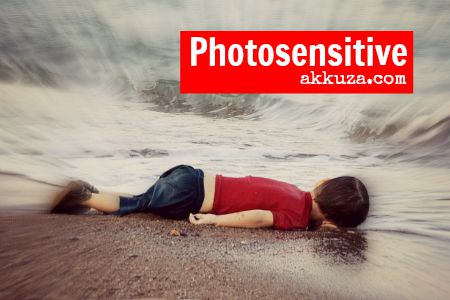Aylan Kurdi’s lifeless body washed up on a Turkish beach.The photo was snapped moments before the body was picked up by a Turkish rescue operator. Within hours it became the internationally recognised symbol of the unfolding Syrian tragedy. Not the thousands of persons bandied across borders, not the hundreds of thousands of unwanted finding doors slammed in their faces, not a whole people that has become a European hot potato much to its own chagrin. No.
Just a little boy in a red t-shirt, shorts and shoes. Face down. Arms along his sides. At first glance it is not so much an image of death as one of exhaustion. Before you are struck by the dark reality of the death of an innocent you are first made to think of an exhausted loss of the will to go on. Then it hits you. This is a dead little boy. And this image has struck home in millions of households. It has been described as the ultimate eye-opener, the straw that broke the camel’s back. Did we really need the image of one dead kid set in a romantic position in order to unlock the last shreds of humanity? If so why?
Memory
Last night Rai3 showed the second of a two piece instalment called “Generation War“. The series, originally called “Our Mothers and Our Fathers” in German follows the fate of a group of five young Germans throughout World War II. The German channel ZDF had commissioned the series in order to act as a dialogue between generations. The series attracted huge criticism in Germany since it seemed to portray the Nazis as “others” to the German population but also served as an eye-opener to the great deception that Nazism had been to the young pre-war generation.
Dealing with history is hard enough. Remembrance and knowledge that results from not forgetting are crucial tools in understanding the freedoms and liberties that have been achieved in the last century. Reading abut Generation War I learnt that the first real big eye-opener in Germany with regards to the horror of the holocaust “only” appeared on TV in the form of a mini-series in 1978 (featuring among others a young Meryl Streep).
The media has an important role in shaping ideas about great events. There was no media as we know it at the time of the holocaust or anti-semite pogroms. Most news was state controlled and played to the tune of the dictatorship. More recently we can see the mediatic effect of reporting of mass exodus such as that of the East Germans in 1989. In fact it should not be too hard to remember that not too long ago the pathways of Austria and Hungary were flooded with another people eager to reach the Holy Grail of German free territory. At the time a collapsing East Germany witnessed a haemhorrage of citizens eager to escape the claustrophobic atmosphere behind the iron curtain.
27 years later East Germans are replaced by Syrians. The plight of the people running away from a war torn country had been gathering momentum for over three years now. It took a symbolic snapshot to bring home the reality. Those who had hitherto been numbed by the excessive amount of daily information covering tragedy after tragedy, war after war, displacement after displacement, were suddenly shocked into action.
Aylan was buried back in his tragic hometown of Kobane. The hopes that humanity can once again stir itself out of its egoistic stupor were not buried with him though. Right or wrong, the stolen snapshot of a dead boy’s curls playing with the waves on a turkish beach might have kicked off the tide of compassion and care that had long been lacking.


